The Sunderbans Bengal Tiger Reserve takes some finding; and getting to it is no mean feat either as the three-hour road trip to Basanti from Kolkata is rough and regularly found my rickety taxi at the bottom of deep potholes which caused it to strain every metal sinew to escape, only to continue on a sea of corrugations that made it creak and rattle in protest.
I arrived at Basanti, where my ferry waited, in the white-hot haze of midday, Being the only white face, my guide soon found me. Niranjan Raptan, is a rugged and amiable fellow with a firm handshake and the look of a man who stood next-door to indestructible. Following formal introductions to the rest of the crew my bags were stowed. Niranjan encouraged me, the only passenger, to make myself comfortable on a thin cushion strategically placed in a shaded area of the deck. He pulled up a plastic patio chair and watched as I married my cameras and lenses.
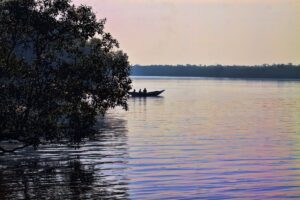 Just as the heat of the day began to melt away and the afternoon turned into a thick mellow evening the ferry coughed to life and set off on a two hour trip into a wide expanse of yellow-gold water heading to Tiger Camp, my accommodations for the next two nights. Caught at the tipping point between day and dark the view was rather splendid but was soon overtaken by darkness. In the distance I spotted tiny specks of light close to island mud banks. These, I was reliably informed, were fishermen checking their nets. Soon the darkness was absolute and somewhat frightening. I enquired from Niranjan why none of the boats, including ours, were lit. This, he announced, was a frivolous expense and not needed; the skipper could hear an oncoming boat and could read the darkness, making a light unnecessary. Unconvinced, I stared intently into the darkness and felt certain sinister shapes surrounded us.
Just as the heat of the day began to melt away and the afternoon turned into a thick mellow evening the ferry coughed to life and set off on a two hour trip into a wide expanse of yellow-gold water heading to Tiger Camp, my accommodations for the next two nights. Caught at the tipping point between day and dark the view was rather splendid but was soon overtaken by darkness. In the distance I spotted tiny specks of light close to island mud banks. These, I was reliably informed, were fishermen checking their nets. Soon the darkness was absolute and somewhat frightening. I enquired from Niranjan why none of the boats, including ours, were lit. This, he announced, was a frivolous expense and not needed; the skipper could hear an oncoming boat and could read the darkness, making a light unnecessary. Unconvinced, I stared intently into the darkness and felt certain sinister shapes surrounded us.
A week earlier, sitting at home in England, glass of wine in hand, a wildlife television programme about the plight of Indian tigers caught my eye and imagination. What I found on Google beckoned with the promise of adventure and mystery. This, in part, goes to explain why I found myself on the deck of a small ferry in the largest single block of tidal mangrove forest in the world. Compared to the mach-4 lifestyle of London, this could easily have been another planet or parallel universe as here, life was at once recognisably similar yet completely different.
‘Two thirds of the Sunderbans falls in Bangladesh,’ Niranjan advised, ‘and that which falls within India’s borders measure some 5,984 miles. Of this the reserve forest occupies 2,649 square miles.’ He shouted an instruction to the skipper, then continued. ‘And 1,606 miles of this is home to some 250 Royal Bengal Tigers which is the largest single population of the species in the world.’ I pondered the math of this statistic and came to the conclusion that the chances of actually seeing a tiger were very slim and wondered if, like in South Africa, the animals were collared and tracked. I made a mental note to enquire after this at another time as we were just tying up at the dock adjacent to Tiger Camp.
I wasn’t expecting anything yuppie or designer and was pleasantly surprised at the neatness and efficiency of it all. Swathed in green foliage, my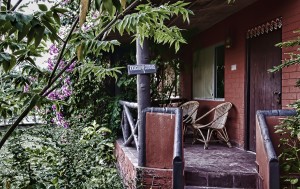 ‘executive cottage’ looked exactly as I’d expected – cocooned by creeper and dark leaved mango trees. Inside was a large room with twin beds, a couple of chairs, a coffee table and an air-conditioner which I immediately switched on. I contemplated the bathroom and wondered how one was meant to wash as other than a (western) toilet and basin, there was a shower cubicle – without a shower head. Instead there was a tap and a bucket.
‘executive cottage’ looked exactly as I’d expected – cocooned by creeper and dark leaved mango trees. Inside was a large room with twin beds, a couple of chairs, a coffee table and an air-conditioner which I immediately switched on. I contemplated the bathroom and wondered how one was meant to wash as other than a (western) toilet and basin, there was a shower cubicle – without a shower head. Instead there was a tap and a bucket.
My nose guided me to the jungle resort restaurant – a large bamboo, reed and thatch structure with open sides. For a person whose introduction to foreign cuisine began and ended with spaghetti out of tins, I found making my way across a continent where everything edible was curried, required a certain amount of vigilance. I lifted the lids off the buffet table pots and stared with private disappointment at the offerings. I started with a few spoons of tomato soup and Naan bread followed by small portions of chana masala, alu dum and crab curry, but was put off my food by the suicide bugs who threw themselves at the low-hanging light bulbs found above each table, and what felt like hovering serving staff.
After a bucket shower, I dressed my bed, put my camera batteries on charge and switched off the air-conditioner and light. I stared up at the ceiling fan which rotated in jerky movements, like a man with a slight limp forced to run for the bus. Travel weary, I drifted off to sleep. There is a part of my mind which, since living in the wilds of Africa, never closes down. Instead it lies in a corner of dusk, somewhere between awareness and slumber – similar to a watchdog separating the familiar hums of his surroundings to an unfamiliar clatter. Without being fully conscious of what I was doing, I found myself pulling on my jeans in a sudden rush of adrenalin. Was it the hothouse of my imagination or was there something outside? I padded across to the window which had misted over in steam-room fog and wiped at it with the bottom of my t-shirt. Only the night looked back at me. Pasted with sweat I quietly unlocked the door and opened it a crack then promptly closed it again; even at night an airless heat hangs over India – the kind of heat that hits you when you open an oven door to check the roast. The following morning tiger paw prints were discovered at the closed gate of the Tiger Lodge.
Over the following two days it was anchors up at dawn, when there was still an early morning mist on what I considered to be the jungle’s infinity pool. By the time the sun rose above the horizon I itched with sweat. The deeper we plunged into the baking tropical landscape the higher the temperature gauge climbed. By noon the sun was pale and intense, sucking out the colour of the day. Even the flies lay down on their backs and just quietly gasped.
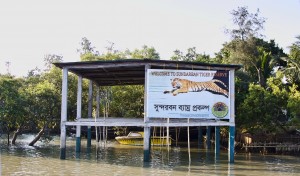 We traversed the river delta for nine, sometimes ten hours each day, spluttering along the outskirts of the salt water mangroves, occasionally dipping into its interiors in search of the elusive Bengal tiger. Other than the perimeter thickets, we were unable to see into the dark jungle. That said though, I had the uncanny feeling of unseen yellow eyes looking back at me.
We traversed the river delta for nine, sometimes ten hours each day, spluttering along the outskirts of the salt water mangroves, occasionally dipping into its interiors in search of the elusive Bengal tiger. Other than the perimeter thickets, we were unable to see into the dark jungle. That said though, I had the uncanny feeling of unseen yellow eyes looking back at me.
Only then did I realise Niranjan had been speaking all day – even if nobody listened. ‘The Sunderbans National Park boasts one the largest number of tigers,’ he pointed out. ‘But finding one is not that easy.’ He contemplated this statement then added. ‘Humans exist at the mercy of the tiger population – this year alone twenty man-eating cases were reported. Twenty,’ he repeated for emphasis. ‘This is a land where jungle law reins supreme, where only the fittest prevail.’
Feeling somewhat despondent I set Niranjan a hard task. ‘Tomorrow is my last day,’ I bleated, ‘you must please find me a tiger.’ He bowed slightly giving me the impression that my wish would be granted. Realistically though, as thousands before me, I would probably leave India without having seen a Bengal tiger.
After a bucket shower I lay spread-eagle across the bed soaking up the coolness. A clinging fog had descended and enveloped the camp in an eerie and impenetrable blanket. I fell asleep with a half eaten apple in my hand.
At dawn the mist-shrouded stillness of the rainforest was especially disquieting. Gnarled skeletal trees leaned over the water, as if to see their reflection. As we puttered along I considered my guide from behind my Raybans. His lean frame exuded tough confidence. His complexion was leathery and his eyelids sagged in tired folds; deep lines framed his mouth. The gray was beginning to win in what was once jet black hair and his dark eyebrows emphasized his intelligent sharp brown eyes.
He spoke with authority, and he should. He lives in the Jungle Book; in fact he has his own Mowgli story involving his uncle, who made the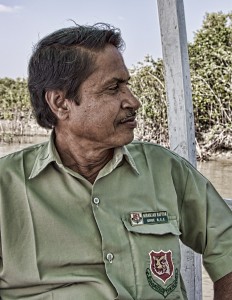 ultimate sacrifice in shielding a young Niranjan from a Bengal tiger who attacked them whilst they were gathering honey in the mangrove forest.
ultimate sacrifice in shielding a young Niranjan from a Bengal tiger who attacked them whilst they were gathering honey in the mangrove forest.
There are no two-way radio communications as found in most high-end game parks or reserves elsewhere in the world. We’re not talking luxury safari boats and champagne either. This is unrefined, unsophisticated and unfenced jungle – and all my crew had first-hand knowledge of it.
The Sunderbans experiences two tidal actions every day exposing the mangrove roots at its low tides. I was astounded to learn that the Bengal tiger is a skilful swimmer, drinks brackish salt water and also feeds on fish and sea turtles. Sustained by this thought I started into the sage green jungle and resolved to conjure up a big cat.
Where the pale aqua of the river merged with the soft mushroom colour of the mud flats at low tide I saw what I thought to be a very large tree trunk. As we drew closer I realised it was a crocodile sunning itself on the bank – its mouth acting as a window. As we neared, it quickly whipped around and flung itself into the water. Its eyes, the only visible part, remained fixed on us as we glided by.
A little further along we dropped anchor and cut the diesel engine. Here the sun seemed to paint the trees and water gold – a picture of tranquillity. Other than the crew regularly clearing their throats and gobbing the mucus overboard, it was silent. No one spoke. There was no sound but the drip of moisture in the jungle, no breeze, no rustle of an animal. Even the dragonflies stopped stitching the water. I instinctively knew something had changed – such profound silence was unnatural. And I could feel we were being watched.
Something startled the monkeys who sat on the mud bank – mother monkey gathered up her little ones and scooted them up the nearest tree then followed them. Halfway up she glared in defiance at a spot in the jungle and vigorously shook a branch, squealing, barking and making loud kissing sounds, which immediately alerted the jungle to imminent danger.
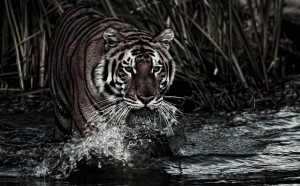 We all instinctively leaned forward. I caught movement in the tail of my eye – something dark. A Bengal tiger stood at the water’s edge, facing the opposite bank. He was at least three metres in length and one metre to the shoulder. His weight looked to be around 220kg. His coat was particularly striking, fading from light orange to yellow with black stripes; his belly was cloud white, and his tail white with black rings. He eyeballed me defiantly, unafraid. He dipped his head, as if collecting his voice from the mud, then scooped it up, lifting his head to the tree tops. His menacing baritone roar was heard two miles away, I was later told. With that he flicked his tail and bounded off back into the darkness of the Sunderbans jungle. At once life resumed, as did the jungle noise, which I’d not noticed until now.
We all instinctively leaned forward. I caught movement in the tail of my eye – something dark. A Bengal tiger stood at the water’s edge, facing the opposite bank. He was at least three metres in length and one metre to the shoulder. His weight looked to be around 220kg. His coat was particularly striking, fading from light orange to yellow with black stripes; his belly was cloud white, and his tail white with black rings. He eyeballed me defiantly, unafraid. He dipped his head, as if collecting his voice from the mud, then scooped it up, lifting his head to the tree tops. His menacing baritone roar was heard two miles away, I was later told. With that he flicked his tail and bounded off back into the darkness of the Sunderbans jungle. At once life resumed, as did the jungle noise, which I’d not noticed until now.
How, I wondered, had Niranjan known where to drop anchor and switch off the engine. I recall him telling me: ‘When I close my eyes I see all – all the creeks and rivers, all the dens and animals. I know the Sunderbans as I know my own house in the dark. This is how I know where my tigers are.’
The diesel engine coughed then fired up and we resumed our journey. By the time we docked I was almost calm. The bush telegraph had clearly been at work as everyone had heard of our sighting. ‘You saw a tiger! You saw a tiger!’ a fellow guest anxiously demanded, both his feet leaving the ground at once. Without waiting for my reply he hastened across to other guests who he felt needed to hear of it again.
The following day, we left Tiger Camp just as the fireflies were starting to dance under the deep shadows cast by the mango trees and the sun just began to set. The shadows didn’t look too suspicious now as I knew who was looking back at me. We passed two long low canoes slipping through the velvety black water and I quietly wondered after that statistic Niranjan had quoted, the one about the number of people who got eaten by tigers. I looked across at him and he met my gaze. He had read my mind and announced brightly that the number may increase to 22 this year. We exchanged smiles then sat back to contemplate the world that the moon had set alight in a cold fire of silver.
SIDEBAR
Getting there? An international flight to Kolkata (Air India is arguably the way to start and end your journey). Hire a driver/car from ITS Transport ( tel +91-983-6069305, daily rates start at Rs 1500) to take and collect you from Basanti.
When to go? The best time of year to visit is October to March, as there’s little rain.
What to take? Insect repellent is essential. As is light cotton clothing. Leave your cotton clothes for the staff. This will provide sufficient space to pack gifts. Take your own towels – those provided are tatty.
What to expect? Breakfast and lunch are served on the boat. Its bush basic, but bearing in mind the locations (in the UK I’d have been on a diet of drizzle and fish fingers) I thought it passable. This, coupled to the endless cups of coffee being served will soon have you needing to make use of the onboard facilities (which thankfully was a western unit – all the ferry boats have them). Unfortunately, though, the boat I was on had a troublesome lavatory door that kept swinging open. I had to hold it shut with a foot, which brought a certain dimension of challenge to anything I had planned to do in there.
The friendly crew and staff back at base are all local; some even speak a smattering of English. In comparison Niranjan’s command of the language, although halting, was good. An additional guide we collected on route kept worrying at a cornflake stuck up his nose and once even picked up one of my cameras and took photographs with it – cheeky sod.
What’s the cost? A mirror experience including food and the executive cottage will lighten your wallet by Rs 5,150.00 (roughly US$115).
The Sunderbans Tiger Camp, Dayapur, PO Gosaba, 24 Paragana (South), www.sunderbantigercamp.com, Email: info@sunderbantigercamp.com


